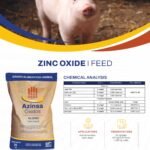Zinc Oxide Feed, 72% or Alizinc
Zinc oxide feed, also known as Allizinc, is a high-purity zinc oxide compound, specifically formulated for use in animal nutrition and agricultural applications. This grade of zinc oxide is characterized by its safety, stability, and bioavailability, making it a reliable source of essential zinc for farm animals and agricultural crops.
Zinc is a vital micronutrient in the diet of animals and plants, participating in multiple metabolic, digestive, and immunological processes. The use of Allizinc ensures that supplementation is done efficiently, providing bioavailable zinc and contributing to healthy growth, disease resistance, and productive performance.
Physical and Chemical Properties
Zinc oxide feed has properties that set it apart from other grades, specifically adapted for animal nutrition and agriculture:
Chemical and physical stability: It withstands mixing with balanced feeds, fodders, and fertilizers without losing its properties.
Safety and compatibility: It does not alter other nutritional or chemical formulations in food and soils.
High functional purity: Free of contaminants, suitable for animal consumption.
Color: Light brown, characteristic of this grade of zinc oxide, which facilitates its identification in mixtures and feed.
Solubility: Slightly soluble in water and soluble in acids, which allows for efficient absorption in both animals and soils.

Frequently Asked Questions (FAQ)
What is Zinc Oxide Feed (Allizinc)? It is a high-purity zinc oxide designed for animal supplementation and agricultural applications, ensuring bioavailable and safe zinc.
In which animals can it be used? Poultry, swine, cattle, sheep (recommended), and other farm animals that require zinc for growth, immunity, and digestive health.
How is it applied in agriculture? Through formulations containing mixtures of other chemical compounds, which allows for improved zinc absorption and crop yield.
Is it safe for animal and environmental consumption? Yes, Allizinc complies with safety standards for animals and does not generate negative impacts when used correctly on soils and crops.


